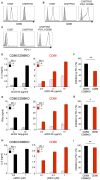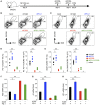PD-1 Primarily Targets TCR Signal in the Inhibition of Functional T Cell Activation
- PMID: 31001256
- PMCID: PMC6455061
- DOI: 10.3389/fimmu.2019.00630
PD-1 Primarily Targets TCR Signal in the Inhibition of Functional T Cell Activation
Abstract
Cancer-immunotherapy targeting programmed cell death 1 (PD-1) activates tumor-specific T cells and provides clinical benefits in various cancers. However, the molecular basis of PD-1 function is still enigmatic. Especially, it is unclear which signaling pathway PD-1 primarily targets. Besides, the capacity of PD-1 to inhibit the T cell receptor (TCR)-dependent activation of T cells in the presence of co-stimulation is also controversial. Here we used co-culture systems of T cells and antigen-presenting cells with targeted deletion and overexpression of co-receptors and ligands and examined the inhibitory potency of PD-1 against T cell activation upon TCR stimulation with CD28 and ICOS co-stimulation. As an unambiguous criterion of T cell activation, we used the acquisition of cytokine production capacity, which represents one of the most important functions of T cells. PD-1 inhibited functional T cell activation upon TCR stimulation in the absence as well as in the presence of CD28 co-stimulation, indicating that PD-1 can directly inhibit TCR signal. Notably, CD28 co-stimulation rather attenuated the efficiency of PD-1 in inhibiting TCR-dependent functional T cell activation. In addition, PD-1 inhibited TCR-dependent functional T cell activation with ICOS co-stimulation as efficiently as that with CD28 co-stimulation. Furthermore, we found that the maintenance of antigen-induced follicular helper T (TFH) cells that required ICOS co-stimulation was persistently restrained by PD-1 in vivo. These findings indicate that PD-1 primarily targets TCR signal in the inhibition of functional T cell activation. Thus, PD-1 functions as the rheostat of T cell activation rather than an inhibitor of a specific stimulatory co-receptor.
Keywords: CD28; ICOS; PD-1; T cell receptor; co-receptor; cytokine production; follicular helper T cell.
Figures







Similar articles
-
The receptor PD-1 controls follicular regulatory T cells in the lymph nodes and blood.Nat Immunol. 2013 Feb;14(2):152-61. doi: 10.1038/ni.2496. Epub 2012 Dec 16. Nat Immunol. 2013. PMID: 23242415 Free PMC article.
-
Program death-1 engagement upon TCR activation has distinct effects on costimulation and cytokine-driven proliferation: attenuation of ICOS, IL-4, and IL-21, but not CD28, IL-7, and IL-15 responses.J Immunol. 2003 Jan 15;170(2):711-8. doi: 10.4049/jimmunol.170.2.711. J Immunol. 2003. PMID: 12517932
-
AP-1 is involved in ICOS gene expression downstream of TCR/CD28 and cytokine receptor signaling.Eur J Immunol. 2012 Jul;42(7):1850-62. doi: 10.1002/eji.201141897. Eur J Immunol. 2012. PMID: 22585681
-
Role of TRAFs in Signaling Pathways Controlling T Follicular Helper Cell Differentiation and T Cell-Dependent Antibody Responses.Front Immunol. 2018 Oct 22;9:2412. doi: 10.3389/fimmu.2018.02412. eCollection 2018. Front Immunol. 2018. PMID: 30405612 Free PMC article. Review.
-
Inducible T-cell co-stimulator: Signaling mechanisms in T follicular helper cells and beyond.Immunol Rev. 2019 Sep;291(1):91-103. doi: 10.1111/imr.12771. Immunol Rev. 2019. PMID: 31402504 Review.
Cited by
-
Biomarkers in Immunotherapy-Based Precision Treatments of Digestive System Tumors.Front Oncol. 2021 Mar 11;11:650481. doi: 10.3389/fonc.2021.650481. eCollection 2021. Front Oncol. 2021. PMID: 33777812 Free PMC article. Review.
-
PD-1 preferentially inhibits the activation of low-affinity T cells.Proc Natl Acad Sci U S A. 2021 Aug 31;118(35):e2107141118. doi: 10.1073/pnas.2107141118. Proc Natl Acad Sci U S A. 2021. PMID: 34433672 Free PMC article.
-
Preclinical evaluation of chimeric antigen receptor T cells targeting the carcinoembryonic antigen as a potential immunotherapy for gallbladder cancer.Oncoimmunology. 2023 Jun 22;12(1):2225291. doi: 10.1080/2162402X.2023.2225291. eCollection 2023. Oncoimmunology. 2023. PMID: 37363103 Free PMC article.
-
Experimental autoimmune encephalomyelitis impairs the immunomodulatory effects of mesenchymal stem cells on splenocyte responses.Mol Biol Rep. 2025 Jun 11;52(1):582. doi: 10.1007/s11033-025-10684-z. Mol Biol Rep. 2025. PMID: 40498218
-
Immune-Mediated Inflammatory Diseases and Cancer - a dangerous liaison.Front Immunol. 2024 Sep 18;15:1436581. doi: 10.3389/fimmu.2024.1436581. eCollection 2024. Front Immunol. 2024. PMID: 39359726 Free PMC article. Review.
References
Publication types
MeSH terms
Substances
LinkOut - more resources
Full Text Sources
Other Literature Sources
Research Materials
Miscellaneous

